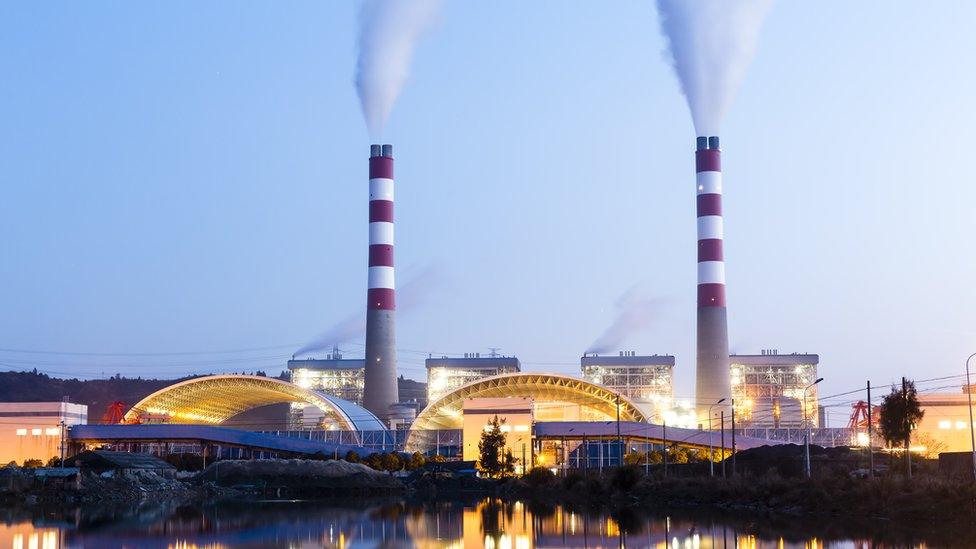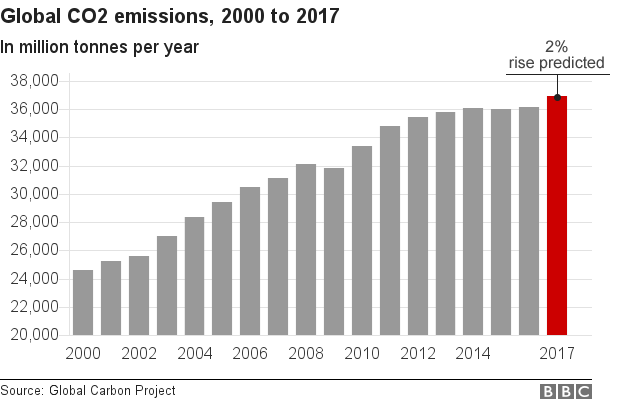First CO2 rise in four years puts pressure on Paris targets
- Published
- comments

Consumption of coal has grown once again in China after three years of decline
Global emissions of CO2 in 2017 are projected to rise for the first time in four years, dashing hopes that a peak might soon be reached.
The main cause of the expected growth has been greater use of coal in China as its economy expanded.
Researchers are uncertain if the rise in emissions is a one-off or the start of a new period of CO2 build-up.
Scientists say that a global peak in CO2 before 2020 is needed to limit dangerous global warming this century.
The Global Carbon Project, external has been analysing and reporting on the scale of emissions of CO2 since 2006.
Carbon output has grown by about 3% per year in that period, but growth essentially declined or remained flat between 2014 and 2016.Concern at first CO2 rise in four years

The latest figures indicate that in 2017, emissions of CO2 from all human activities grew by about 2% globally.
There is some uncertainty about the data but the researchers involved have concluded that emissions are on the rise again.
"Global CO2 emissions appear to be going up strongly once again after a three-year stable period. This is very disappointing," said the lead author of the study, Prof Corinne Le Quéré from the University of East Anglia.
"With global CO2 emissions from human activities estimated at 41 billion tonnes for 2017, time is running out on our ability to keep warming well below 2 degrees C, let alone 1.5C."
The most important element in causing this rise has been China, which is responsible for around 28% of the global total. Emissions there went up 3.5% in 2017, mainly because of increased coal use, driven in the main by a growing economy.

US coal production has increased slightly this year mainly due to export demand
Another important factor in China has been lower water levels in rivers which have seen a drop in the amount of electricity made from hydro-power, with utilities turning to coal and gas to make up the shortfall.
US emissions have continued to decline but the fall has been less than expected. Higher prices saw a drop in the use of natural gas for electricity - with renewables and hydro-power picking up the slack.
Coal use has also grown slightly in the US this year, with consumption up about a half of one percent.
India's emissions are projected to grow by about 2%, which is a considerable decrease from around 6% per year over the last decade.
However, experts believe that this may be a temporary drop-off caused by a number of factors that have hampered the consumption of oil and cement.
Action required
Europe also saw a smaller decline than expected, falling by 0.2% compared with 2.2% over the last 10 years.
One common theme around the world is continued use of gas and oil, says Prof Le Quéré.
"There have been lots of ups and downs in the use of coal but in the background there has been no weakening in the use of oil and gas. And that is quite worrisome."
The report has been launched in Bonn where UN negotiators are trying to move forward with the rules for the Paris climate agreement.
Researchers involved with the study say they are not moving fast enough.
"Lots of diplomats are working out the rules but that is all a little bit meaningless unless they go back home to their countries and ratchet up climate action and that is where the gap is," said Dr Glen Peters, from the Centre for International Climate Research, external in Norway.
"These countries have to be pushing on with the policies, but everything keeps getting pushed back."

Demonstrators at UN talks in Bonn demand faster cuts in carbon
The report is sure to increase tensions in Bonn between developed and developing nations.
There is increasing resentment about the fact that all the focus is on future commitments made under the Paris climate agreement but very little on the years before it becomes active.
Poorer countries want the richer ones to increase their carbon-cutting actions over the next three years.
"The climate will not let us wait until 2020 when the Paris agreement comes into force," said Nicaragua's chief negotiator, Paul Oquist.
"Climate change is happening now and it's vital that immediate actions to cut emissions become a feature of this summit."
The new research on carbon emissions has been published simultaneously in the journals Nature Climate Change,, externalEarth System Science Data Discussions, external and Environmental Research Letters, external.